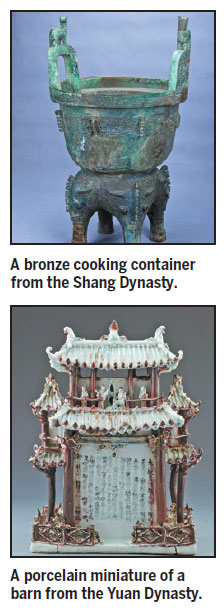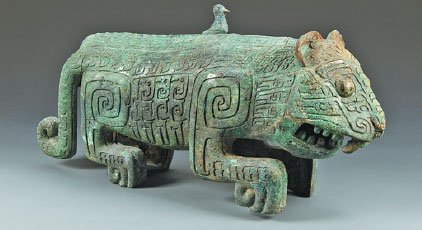Exquisite ceramic, bronze and silk
Updated: 2014-03-20 07:29
By Sun Yuanqing (China Daily)
|
|||||||||||
Jiangxi province is showcasing some of its most precious cultural relics at the Capital Museum in Beijing for the first time. Almost half of the 160 items are first-class national treasures. They include bronze wares, ceramics, jade wares, silks, calligraphy and paintings.
Interlocked with rivers and mountains in the hinterland of East China, Jiangxi was a pioneer in China's ancient ceramic industry, bronze manufacturing and silk making.
The first of the three sections in the exhibition is dedicated to bronze ware from the Shang Dynasty (c. 16th century-11th century BC), which were unearthed in Dayangzhou in Jiangxi in 1989. With 475 bronze weapons and agricultural tools, the discovery unveiled Jiangxi's social prosperity even before the Han Dynasty (206 BC-AD 220). It also provides abundant material for the study of the development of China's bronze ware.
A bronze cooking container, which is also the largest bronze ware from the Shang Dynasty, is exhibited. The container features delicate patterns and has two deer on each side of the top, showcasing the high skill level of that time.
"Unlike the bronze ware in North China, none of these are inscribed with words. They are more vivid and have a more realistic style compared to North China," says Cui Xue'an, consultant of the exhibition and secretary-general of the Beijing Museum Society.
The second session of the exhibition reviews the history of ceramic making in Jiangxi, which dates back more than 20,000 years.
Jingdezhen, a town in Jiangxi, was an imperial ceramic-making basement in the Ming (1368-1644) and Qing (1644-1911) dynasties, making Jiangxi the hotbed for China's ceramics industry.

One highlight is a pottery bowl with the veins of a leaf on the inside. Pei Yajing, a ceramic specialist from the Capital Museum, explains that when the bowl is filled with tea, the veins will create the illusion of a floating leaf.
"It is not known how the idea was conceived. We guess the leaf might have fallen into the bowl by coincidence when it was being made and later developed into a new decoration method," Pei says.
A porcelain miniature of a splendid barn unearthed from the tomb of a local official from the Yuan Dynasty (1271-1368) is also on display. Glazed with blue, white and red colors, the model is a true rarity that is seldom exhibited.
The third section of the exhibition shows exquisite silk products and paintings from ancient times.
Highlights include a yellow brocade robe with a dragon design and yellow brocade embroidered shoes unearthed from the tomb of prince Yixuan.
Paintings and calligraphies by Zhu Da, a renowned painter and calligrapher and descendent of the Ming royal family, are also exhibited.
sunyuanqing@chinadaily.com.cn
|
A Shang Dynasty (c.16th century-11th century BC) bronze lion. Photos Provided to China Daily |
|
A Song Dynasty (960-1279) ceramic figurine. |

(China Daily 03/20/2014 page22)
Today's Top News
Australia to resume ocean search for missing jet
Michelle Obama starts landmark trip
Russia starts sanction against US
China opens more maritime space for development
Germany to inquire into US syping
Experts warn as yuan dips further
Hotline helps smokers 'start quitting'
Australia finds possible debris from MH370
Hot Topics
Lunar probe , China growth forecasts, Emission rules get tougher, China seen through 'colored lens', International board,
Editor's Picks

|

|

|

|

|

|







